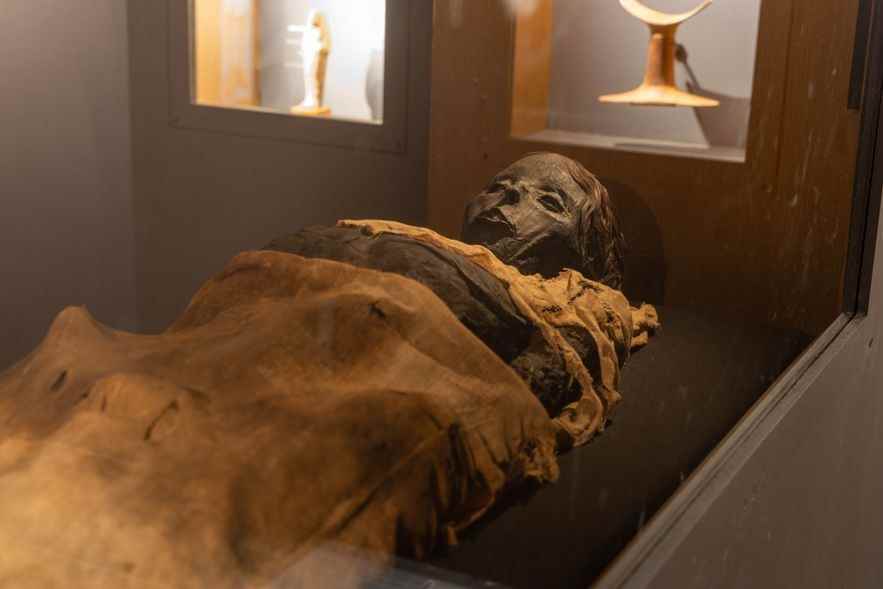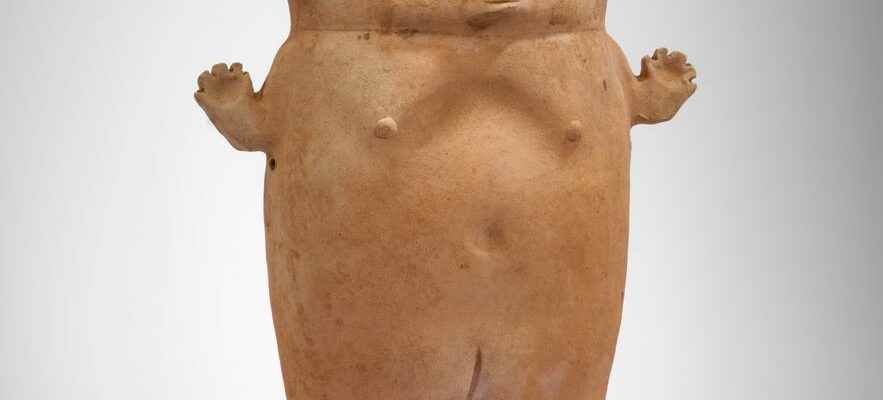By definition, there are two kinds of successful exhibitions: those that impress by the richness of what they present and those that raise questions by making those who come out of them more intelligent. “Mummies, preserved bodies, eternal bodies” proposed by the Museum of Toulouse until July 2, 2023 undeniably belongs to the second category. Far from stopping to show only emblematic Egyptian mummies, this extraordinary journey through time questions each individual about their link with death, which varies over time and according to the place of the globe. “We wanted to talk about the relationship to eternity but also review the different funerary practices: what do they have in common, in fact, between burial, embalming, cremation, composting the bodies (authorized in Belgium) or cannibalism again?, explains Francis Duranthon, the director of the Museum. These subjects touch on the intimate so that we were careful not to shock. Thus, throughout the exhibition, a “sensitive gaze” pictogram was affixed near certain artefacts to warn the visitor. “And all of our staff have received the help of a psychologist to answer questions and anticipate certain reactions”, adds Isabel Nottaris, the deputy director.
Death is inseparable from the cycle of life, it is inevitable and makes us all equal. As if to demystify it, the exhibition that opens with the Latin formula “Memento Mori” (“Remember that you are going to die”), recalling the futility of existence, first attempts to address the physical process of the decomposition of bodies. We would be nearly 108 billion human beings to have, sometimes briefly stayed on Earth. What happens to our remains, once the last breath is released? “It passes from corpse to skeleton through a long process of putrefaction that we explain, in particular by highlighting the role of certain insects, explains Patrice Georges-Zimmermann, the scientific curator, Doctor in archaeo-anthropology at the National Institute for Preventive Archaeological Research (INRAP). Death seen as a natural process provides nutrients to many animal and plant species.
Exhibition at the Toulouse Museum in 2022/2023
© / Exhibition at the Toulouse Museum in 2022/2023
Death is also and above all a matter of cultures. Almost always, man celebrates his deceased. Already Neanderthal buried his own and all civilizations had their own practices. Most are sad like Catholic funerals, but others can be filled with joy, like Mexico’s Day of the Dead (El dia de los Muertos) on November 2. “It is a festival dating back to the Aztecs that marks the return to Earth of the souls of deceased beings with whom the living communicate by going to the cemetery to make offerings, picnic, pray, listen to music and dance”, assures Fabien Laty, the project manager of the exhibition who wanted to show that this question can be approached in a jovial way.
Mummification, an ancestral practice
Then, in his relationship with the beyond, Man did not wait for the libertarians to, failing to prolong life, try to preserve the body. The best known practice is mummification. Contrary to popular belief, it is not in Egypt that the oldest traces date back, but in the middle of the Atacama Desert in Chile, nearly 7,000 years ago. There, the civilization of the Chinchorros developed very elaborate techniques. “This desire to preserve the physical integrity of the disappeared is found everywhere and at different times: among the Andean peoples therefore, but also in Alaska (Aleuts), China (Hans), the Philippines (Igorot), New Guinea ( Dani), in Australia (Torrès), in New Zealand (Maori) and of course in Egypt from the end of prehistory to the Copts of the 12th century, i.e. for five millennia”, enumerates without exhaustiveness, Francis Duranthon. Hence an art of mummification which has evolved considerably through successive stages: washing of the body, removal of certain muscles, organs (except the heart); removal of the brain by nasal manipulation; drying of the body with natural salt; filling the cavities with plants, sediments or ashes to restore volume; massage of the skin with perfumed balms, coating of the body with a mixture of resin and bitumen (to protect them from necrophagous insects); adding a clay mask and different pigments; wrapping the body with bandages or a shroud.
The technique has even continued to be perfected, almost to the present day, as evidenced by the famous mummified bodies (Lenin or Ho Chi Minh). For each of the steps, the masters of embalming use a number of instruments and products: embalming knives, decerebration hooks, strips, vases, oil, natron (salt to dry out the body), aromatic plants, etc. The exhibition also focuses on less known and surprising practices such as the fardo, small funeral packages, used in the Chançay culture in Peru (between 1200 and 1400 AD) where the bodies are wrapped in anthropomorphic textiles. The Quai Branly museum (Paris) has lent a particularly moving example of a five-year-old boy, placed in a fetal position, head down, and who was surrounded by foodstuffs to accompany him to the afterlife. Another amazing tradition, self-mummification experienced in Asia: according to certain Buddhist beliefs, a monk could test his religious fervor by mummifying himself during his lifetime, that is to say through a rigorous ascetic process aimed at eliminating the water and body fat in order to limit post-mortem putrefaction as much as possible.

Exhibition at the Toulouse Museum in 2022/2023
© / Toulouse museum
Hidden treasures in the permafrost
“Sometimes mummification is not intentional but natural,” continues Patrice Georges-Zimmermann. Mostly after an accident. The best-known example is that of the mummy of ötzi, discovered in 1991 and whose body, remarkably preserved by the ice of the Alps (between Italy and Austria), dates back… 5,200 years! Other bodies have been found in different environments such as humid and oxygen-poor peat bogs, like the Tollund man (4th century BC) in Jutland (Denmark) whose perfectly preserved face remains poignant by the delicacy of his features. Without forgetting, finally, the permafrost which, with global warming, allows real treasures to reappear on a recurring basis, such as the leg of a woolly mammoth over 12,000 years old which belongs to the National Museum of Natural History (MNHN).
In this face-to-face with death, proposed by the Toulouse exhibition, there is obviously something… morbid. But its designers have done everything not to offend the public. In addition to the famous pictogram, they also sought to remain modest, or gave the choice to look or not at certain windows. This is the case, for example, of the mummy of an Egyptian woman present in their collections for decades and which has been the subject of a restoration. They took the opportunity to launch a scientific X-ray study: “Tomography and 3D scanners allowed us to discover that she is in fact made up of two individuals, her legs not being hers”, reveals Benjamin Moreno , the director of IMA Solutions, specialist in 3D digitization and enhancement of cultural and scientific heritage. A special place is given to this body revealed in a discreet alcove of the exhibition. On one side, a device to show on a screen the size of a sarcophagus, each stage of the analyses, with a very rigorous virtual reality model. On the other, the mummy is placed in a dedicated showcase with a tinted glass wall: by pressing a button, the visitor can see it or leave it in the dark. Initially, all these treasures were not intended to be displayed in this way for all to see. Like a symbol, this black glass which becomes transparent if you decide to press a button, shows the concern not to offend, just as much as it is a way of honoring the fundamental notion of the respect due to the dead and to the human body.
